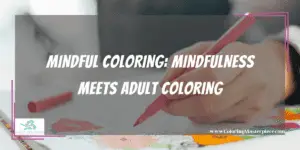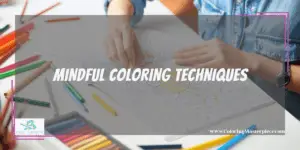Two concepts have become super popular in recent years: mindfulness and adult coloring. Because both of these things are proven to add so much benefit to people’s lives, it only makes sense to combine them. So what exactly is mindful coloring?
Both mindfulness and coloring are proven to decrease stress and improve mental performance. Put them together, and you have a powerful tool to add to your self-care toolbox.
Mindful Coloring: Mindfulness Meets Adult Coloring

Mindful coloring is just what it sounds like coloring mindfully. Okay, so what does that mean? Well, let’s break it down into two components: mindfulness and coloring.
What Mindfulness Is
Although many people picture sitting cross-legged with their eyes closed when they think of meditation, it’s possible to meditate during everyday activities, too. Mindful coloring is a form of active mindfulness meditation.
Mindfulness meditation is the process of bringing the mind to focus on the present moment. This may sound strange to some people, but it’s common to think about something else while doing an activity if you think about it. A lot of the time, our thoughts will drift towards:
-
-
-
- The past
- The future
- Planning
- Daydreaming
- Ruminating
-
-
Mindfulness helps us focus intensely on what we’re doing, noticing every aspect of the everyday experience, rather than letting our mind drift.
As you probably guessed, mindfulness while coloring means just that – bringing the mind’s attention to the action of coloring.
We’ll get more into the reasons for practicing mindfulness a little bit later on, but first, let’s take a look at coloring.
What Adult Coloring Is
Chances are, if you’re interested in mindful coloring, you already know a little bit about coloring in general.
But just in case you’re entirely new to this hobby, adult coloring is precisely like the coloring you remember doing back in primary school, except that the coloring books for adults tend to be more intricate. The subject matter is geared towards an older audience.
In general, coloring reduces stress and provides a much-needed break from hectic modern life, but many coloring books are focused on mindful coloring. These books tend to focus on soothing, repetitive patterns and symmetrical shapes like mandalas.
Although these particular interest coloring books are excellent, please keep in mind that you can utilize mindful coloring on any coloring book or page.
It’s also worth noting that mindful coloring isn’t only for adults – children benefit from mindfulness-based activities just as much as adults do. If you try mindful coloring out and find it useful, consider teaching it to your kids as well—the techniques listed below work just as well for kids or adults.
What Are the Benefits of Mindful Coloring?
Mindfulness and coloring are proving to be helpful with many of life’s ailments. Mindful coloring can help you:
-
-
-
- Reduce Stress and Anxiety
- Lower Blood Pressure
- Get a Good Night’s Sleep
- Improve Mental Focus
- Reduce Chronic Pain
- Be Less Reactive
-
-
In addition to providing you with an excellent way to relax and pass the time, mindful coloring can improve your overall well-being.
Interested in the science behind adult coloring? Check out Why Adults Like Coloring Books, According to Science.
Mindful Coloring Techniques

The following mindfulness techniques will get you started on the road to mindful coloring.
Regardless of which technique you use, the basic instructions are:
-
-
-
- Bring your mind to the object of focus.
- Try not to think about anything else. Don’t force thoughts away, but let them drift away by keeping your mind on the object of focus.
- If at some point you realize that your mind’s completely wandered off (and it will happen), gently redirect it back to the object of focus
-
-
The main thing to remember when practicing mindfulness is that it’s like training a muscle.
Every time you catch your mind wandering off and redirect it back, you’re strengthening your mindfulness muscle.
Your brain is more likely to jump from thought to thought – that doesn’t mean that you’re doing it wrong. Just be patient and gentle with it, and know that that’s the whole point of the practice. The more you do it, the more your mind will learn to settle on one object.
The below techniques follow the basic mindfulness guidelines above, but each uses a different object of focus.
Focus on coloring
If you’d like a general mindfulness exercise that you don’t want to have to think too hard about, try merely being mindful of the act of coloring itself.
Move slowly and purposefully as you choose colors and fill in the pages, and notice things like:
-
- How does the coloring tool feel in your hand? It is smooth, rough, heavy, or thin?
- How does the tool feel on the page? Does it glide along effortlessly, or is there more “grab” due to a dryer medium or more textured carrier?
- How does your arm feel as it sweeps back and forth across the page with each stroke? Are you using broad, sweeping gestures or more small, controlled movements?
These are just some of the questions you can ask yourself to keep your focus on the act of coloring rather than letting the mind drift around.
Some people new to mindfulness find a general technique like this less intimidating than narrowly focusing on something like the breath. However, others find that they struggle more to keep their mind focused when they don’t have a more specific object of focus.
Try it and see what you think – you might decide to alternate between multiple techniques depending on what you need on any given day.
Focus on the Breath
The most traditional point of focus for mindfulness meditation is the breath. To use breath as the point of emphasis during mindful coloring, set up your coloring area and get settled.
Then, before you begin coloring:
-
- Close your eyes or soften your gaze
- Take several slow, deep breaths, noticing how they feel. You can generally see how breathing thinks in the body or focus your attention on a specific point, such as:
-
-
-
- How the air feels going in and out of the nose
- How the air feels at the back of the throat
- The belly, chest, or shoulders are moving with each breath.
- Your clothes are subtly moving against your skin with each breath.
-
-
-
- Relax your breathing to a normal rate, but still keep most of your focus on the breath.
- Open your eyes if they were closed.
- Begin coloring, maintaining contact with the breath throughout the coloring session
Mindfulness of breath is an incredibly useful mindfulness meditation technique since it’s something you can always tap into, regardless of what you’re doing.
Try a Mantra
Mantras don’t always have to be in an ancient language or referencing a deep intention. Many mindfulness meditators have success in maintaining focus by repeating words or phrases, regardless of what they are.
In the case of mindfulness of coloring, mantras can be as simple as:
-
- Repeating the name of the color you’re using.
- Naming the shape, you’re filling in.
- Repeating the pattern, you’re making (back and forth, around and around)
It may sound strange, but giving your mind words to repeat can help it focus and drive away distracting mental chatter.
Observe Bodily Sensations
If you’d like something more tangible to focus on but don’t like using the breath as an object of focus, you might prefer using other bodily sensations.
You can do this technique one of two ways:
-
- Scan your body with awareness from head to toe, focusing on whatever sensation is most prevalent at any given time, noticing it without judgment. Then, let it go and focus on the next craze that calls for your attention and does the same thing with that one.
- Pick one sensation to focus on and keep that sensation in mind while coloring. If your mind drifts away, gently bring it back
Example sensations to focus on are:
-
- Any aches or pains that arise
- The feeling of your weight in the chair or feet on the floor
- The sensation of your clothes against your body
- The feeling of the air around you – is there a breeze? Is it warm or cold?
This technique can take some getting used to but is another great one to bring into any situation.
Ready to start Mindful Coloring? Click here to download my free adult coloring eBook and sign up for my email newsletter!
Disclaimer: The information provided by ColoringMasterpiece.com (“The Site”) is for general informational purposes only. All information on the Site is provided in good faith, however, we make no representation or warranty of any kind, express or implied, regarding the accuracy, adequacy, validity, reliability, availability, or completeness of any information on the Site. Under no circumstance shall we have any liability to you for any loss or damage of any kind incurred as a result of the use of the Site or Reliance on any information provided on the Site. Your use of the Site and your reliance on any information on the Site is solely at your own risk. This blog post is for educational purposes only and does not constitute legal advice. Please consult a legal expert to address your specific needs.
Terms and Conditions: https://coloringmasterpiece.com/terms-and-conditions/

